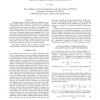Free Online Productivity Tools
i2Speak
i2Symbol
i2OCR
iTex2Img
iWeb2Print
iWeb2Shot
i2Type
iPdf2Split
iPdf2Merge
i2Bopomofo
i2Arabic
i2Style
i2Image
i2PDF
iLatex2Rtf
Sci2ools
CORR
2011
Springer
2011
Springer
Efficient Maximum Likelihood Estimation of a 2-D Complex Sinusoidal Based on Barycentric Interpolation
This paper presents an efficient method to compute the maximum likelihood (ML) estimation of the parameters of a complex 2-D sinusoidal, with the complexity order of the FFT. The method is based on an accurate barycentric formula for interpolating bandlimited signals, and on the fact that the ML cost function can be viewed as a signal of this type, if the time and frequency variables are switched. The method consists in first computing the DFT of the data samples, and then locating the maximum of the cost function by means of Newton’s algorithm. The fact is that the complexity of the latter step is small and independent of the data size, since it makes use of the barycentric formula for obtaining the values of the cost function and its derivatives. Thus, the total complexity order is that of the FFT. The method is validated in a numerical example.
| Added | 19 Aug 2011 |
| Updated | 19 Aug 2011 |
| Type | Journal |
| Year | 2011 |
| Where | CORR |
| Authors | J. Selva |
Comments (0)

